Table of Contents
QUICK SUMMARY:
Video advertising metrics are essential tools for analyzing video ad performance on digital platforms, providing insights into viewer interactions and campaign effectiveness. This guide highlights the crucial video ad metrics to track, underlining their role in strategic decision-making and campaign adjustments for enhanced outcomes.
After weeks of meetings, ideation, and signoffs, you finally have a video marketing strategy in place for your client, which includes running video advertising campaigns. Phew!
You prep your campaigns, the video ads go live, you report on results. The cleanest three-act story if there ever was one... but before we roll the credits, let’s have a close-up on that ending.
Are you tracking the video advertising metrics that matter? And are you sure that your client understands exactly how that carefully crafted video advertising strategy your agency created is delivering value?
Today we’re going frame by frame on the results analysis portion of your agency’s video advertising efforts, sharing the most important metrics to track.
The Importance of Video Advertising Metrics
The power of video to build brand awareness and drive conversions speaks for itself–89% of consumers want to see more online videos from brands in 2024. But simply running ads isn’t enough to achieve consistently successful client outcomes.
Any experienced marketer will tell you that video metrics and analysis are non-negotiable for a successful video marketing strategy. It’s a guiding force for achieving marketing goals.
The same is true for video advertising, programmatic or not. Without tracking the performance of your client’s video ads, you won’t know what’s working and what’s not–and the next steps to take in each case.
If something in a video ad campaign is working, then you’ll know to build upon it for the next. If something isn’t working, then you’ll know how to improve its performance. This is perhaps most important in demonstrating your agency’s expertise to clients. More on this later.
The tie-in here, of course, is to profitability. By tracking video performance, you identify what’s delivering results, and optimize advertising costs toward maximizing your clients’ ROAS and ROI.
Video advertising is the best medium to show off a brand's personality and the benefits of a product or service. It can grab the attention of your easily distracted target audience like no static graphic can. But it takes work to make a solid ad.
Paul Echols, Creative Director and Owner, Square 205
The Basics of Video Advertising Metrics
What Are Video Ad Metrics?
Video advertising metrics are units of measurement for assessing the performance of your clients’ online video ads.
Types of Video Ad Metrics
Each social media platform has its own set of metrics for online video ads.
On Facebook and Instagram, Meta provides the following metrics for video ads:
Two-Second Continuous Video Plays and Cost Per Two-Second Continuous Video Play
Three-Second Video Plays and Cost Per Three-Second Video Play
ThruPlays and Cost Per ThruPlay
Reach
Amount Spent
Video Plays and Video Plays at 25%, 50%, 75%, 95%, and 100%
Video Average Play Time
On YouTube, Google provides the following video marketing metrics:
Impressions for In-Stream, In-Feed, and YouTube Shorts Ads
Paid Views for In-Stream, In-Feed, and YouTube Shorts Ads
Interactions and Engagements
View Rate
Average and Maximum Cost Per View
Earned Actions
“Video Played To”
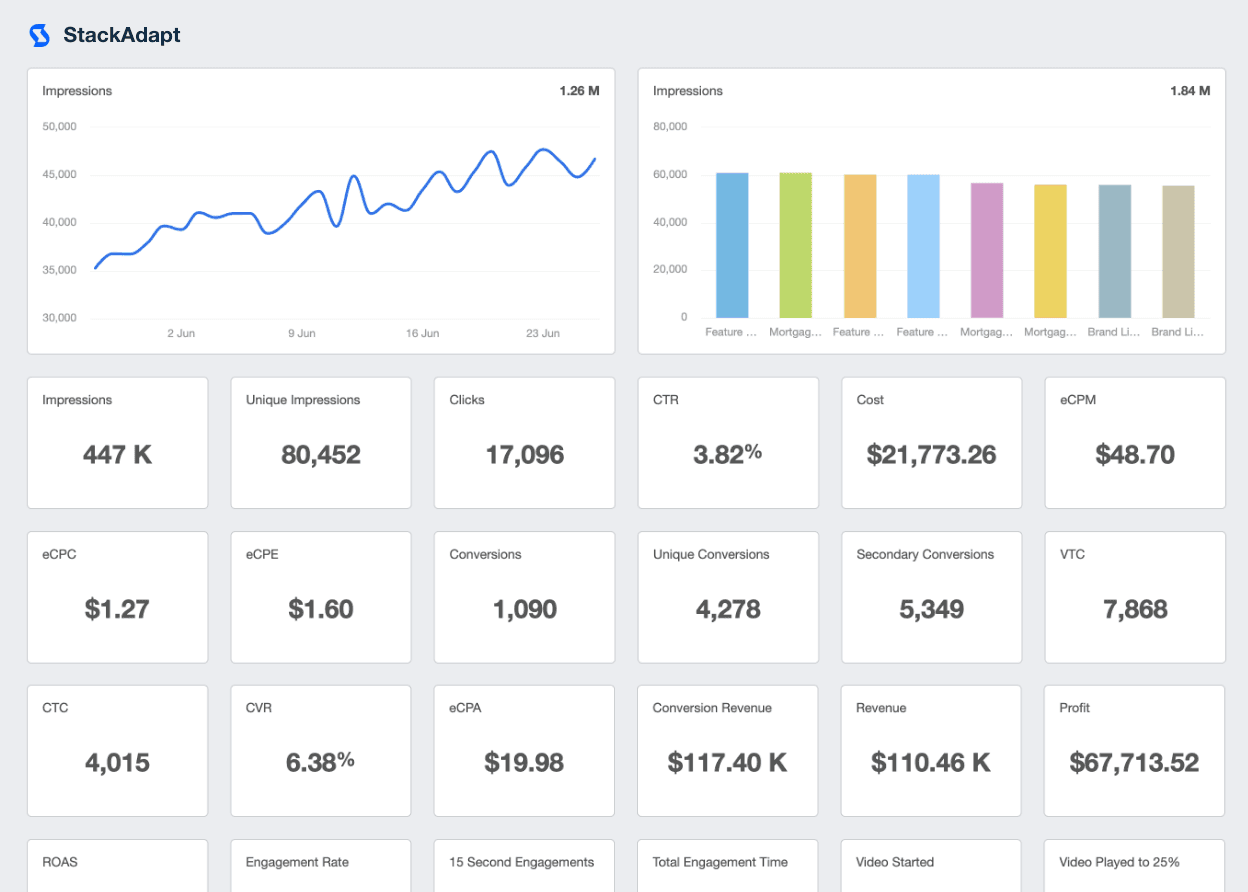
Monitor key metrics from your clients’ programmatic video campaigns using the StackAdapt dashboard integration. Highlight ROAS and monitor conversions in real-time–try AgencyAnalytics free for 14 days.
Key Video Advertising Metrics to Track for Client Success
In the next sections, we outline the key metrics that should inform your clients’ video advertising KPIs. Remember, a metric and a KPI are two different things. A metric is a single quantifiable unit of measure, while a KPI is a measure of performance toward a specific business goal within a specified time period.
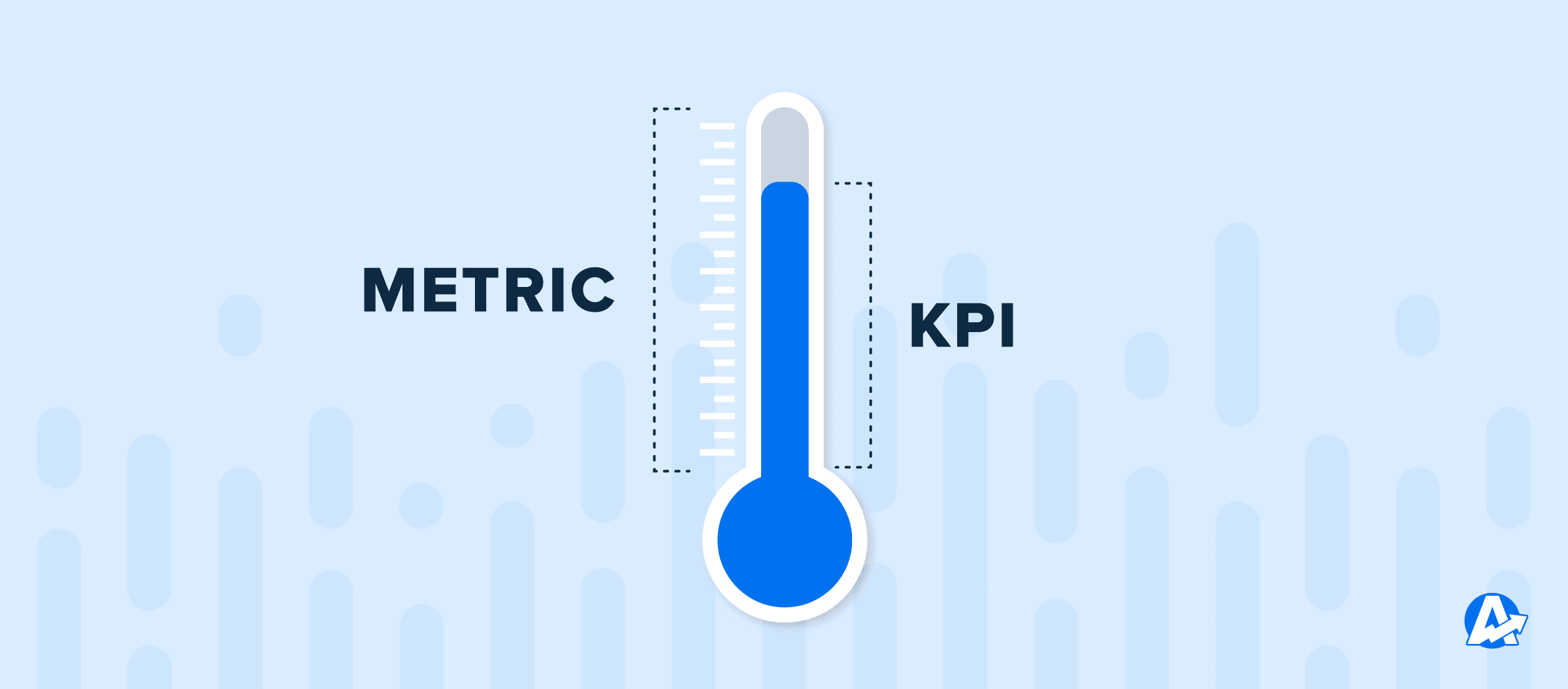
As your client’s video advertising strategy matures, consider setting OKRs for those clients eager to work to an ambitious goal (or two) with aggressive targets. As an extension to the goal-setting system, an OKR is set in tandem with KPIs for your more aspirational clients.
For example, video views is a metric. Monthly video views could be a KPI. Running a set number of marketing campaigns on YouTube every month could be a key result to meet the objective of having one million views by the end of Q3.
Now that we have an understanding of what qualifies as a video advertising metric, let’s take a closer look at the 7 most important types of video advertising metric your agency should be tracking.
1. Viewability
What Is Viewability?
Viewability, or viewable impressions, is a video advertising metric that measures the actual number of times an online video ad has been seen by real people. This is separate from served impressions, which is the number of times an ad has been delivered by the ad server.
How To Measure Viewability of Video Ads
As per the guidelines set by the Media Rating Council and Interactive Advertising Bureau, an online video ad is counted as viewable when at least 50% of it is visible on the screen for at least two seconds while the video is playing.
The following formula is used to measure the viewability rate of online video ads:
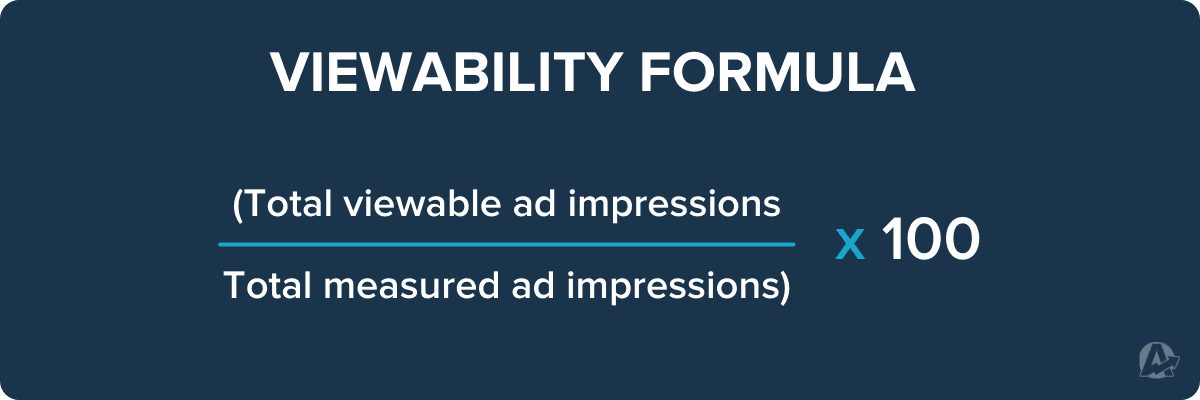
Why Viewability Matters for Video Ads
Since viewability captures how many times ads have been seen rather than merely displayed, it’s a more accurate video advertising metric for measuring reach than served impressions. Thus, paying for viewable impressions is a smarter allocation of your client’s video advertising budget.
2. Completion Rate
What Is Completion Rate?
Video views tell you how many people started watching a video, but what about finishing it? Video completion rate is a video advertising metric that measures the percentage of viewers who watched an online video ad in its entirety.
How To Measure Completion Rate of Video Ads
The following formula is used to measure the completion rate of online video ads:
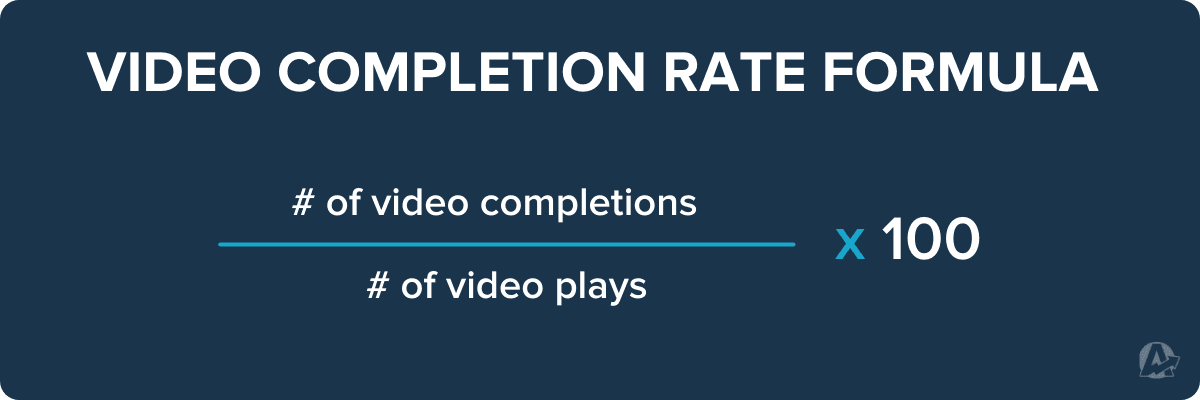
Why Completion Rate Matters for Video Ads
Completion rate tells you whether your client’s video ad sustained the attention of viewers. If it achieved a high completion rate, congrats! This means the video content was compelling enough to keep viewers interested for the duration of the ad.
Viewers are exceptionally discerning with their time, so intentionally investing the time to watch an entire ad is a great indication of its value to them. If a video ad had a low completion rate, use this information to understand what your client’s target audience doesn’t want to see and adjust video content accordingly.
Most businesses know that running ads on Google or Facebook is a necessity these days. But there can be a lot of competition that can make it hard to stand out with a smaller budget. YouTube is great to get your brand out in front of your consumers when you have a smaller marketing budget!
Christina Cypher, Director of Marketing, Click Control Marketing
3. Engagement
What Is Engagement?
Engagement is a video advertising metric that measures the extent to which people are interacting with your client’s video ad. It includes all the ways viewers interact with online video ads, such as:
Reactions
How To Measure Engagement in Video Ads
The sum of all these individual interactions is used to measure engagement rate. Use the following formula to calculate the exact engagement rate of online video ads:
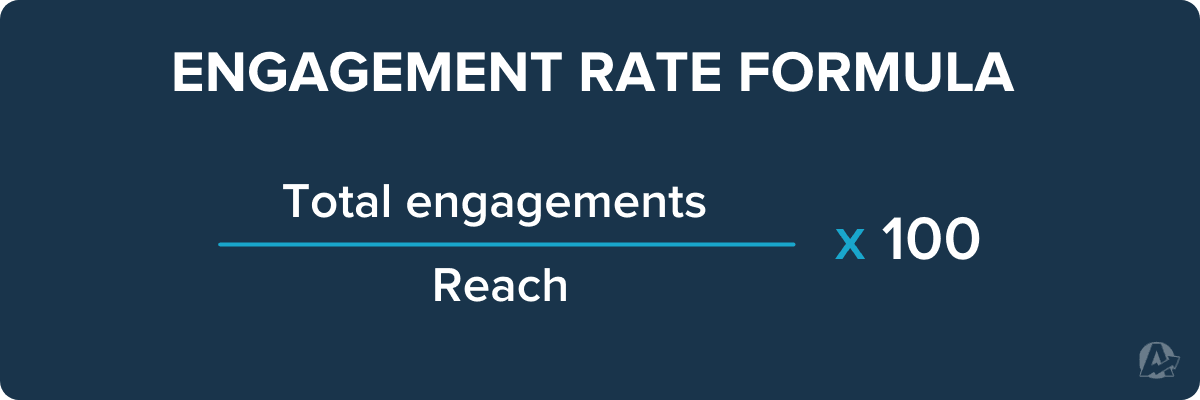
Why Engagement Matters for Video Ads
Engagement is a good indication of how well your client’s video content is resonating with viewers. It also helps two-fold with reach: Firstly, the more a video ad is shared, the wider the audience for it–perfect for increasing brand awareness. Secondly, the more engagement a video ad receives, the more the algorithm continues to distribute it on social media feeds.
Video marketing success depends on what we ultimately want the video to achieve, whether it's to sell a new product or build brand awareness. But generally, our most important KPIs are view count, social media shares, engagements, impressions, CTRs, and video completions.
Michelle van Blerck, Communications Manager, Digital Freak
4. Brand Lift
What Is Brand Lift?
Brand lift is a favorable rise in brand perception among consumers. Brand lift studies are used to determine if a ‘lift’ occurred and to what extent.
Brand Lift tests are available for video ads on Facebook and Instagram, as well as for in-stream and bumper ads on YouTube. A test is free to create, but there are minimum budget requirements for the campaigns used to run the test. Additionally, Brand Lift is not available for all Google Ads advertisers.
When you create a test, you provide a poll with up to three questions that will be shown for the test’s duration.
How To Measure Brand Lift in Video Ads
The poll responses from people who were exposed to your client’s video ads (the test group) are compared to those who were not (the control group). The difference in performance between the two groups is a measure of any brand lift that took place.
On YouTube, the Brand Lift metrics are:
Lifted Users and Cost Per Lifted User
Absolute, Headroom, and Relative Brand Lifts
Baseline and Exposed Positive Response Rates
Baseline and Exposed Survey Responses
Additionally, performance is segmented by up to three of the following metrics (which you will have chosen at the time of creating the test):
Ad Recall
Brand Awareness
Consideration
Favorability
Purchase Intent
On Facebook, the Brand Lift metrics are:
Estimated Incremental Number of People who remembered seeing the ad
Cost Per Incremental Person who remembered seeing the ad
Percentage Point Lift
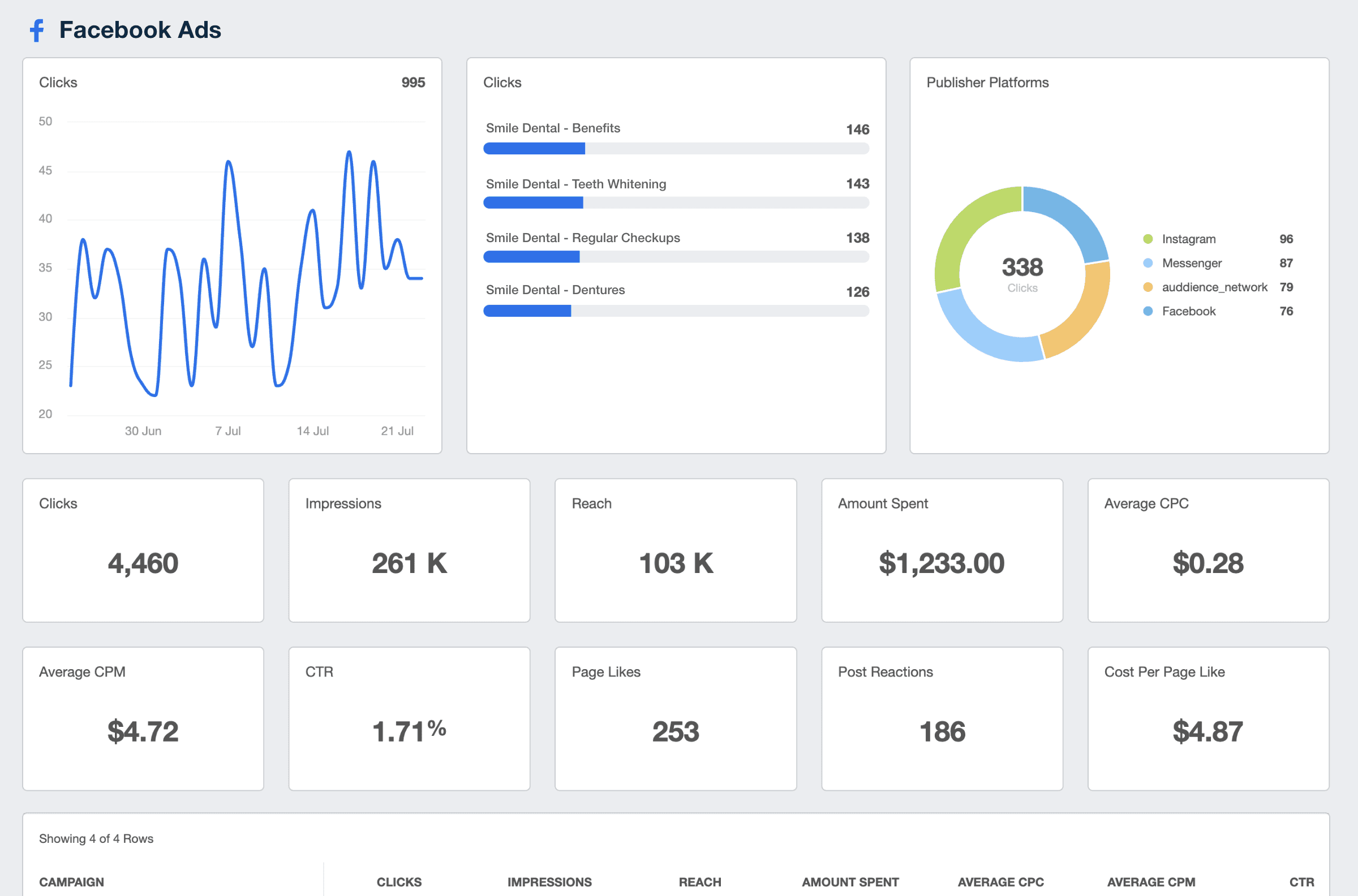
Grant clients access to 24/7 video ad campaign performance monitoring with the AgencyAnalytics Facebook Ads dashboard. Try it free for 14 days.
Why Brand Lift Matters for Video Ads
Investing in brand lift is about playing the long (marketing) game. Tests won’t result in an immediate jump in sales, but will allow advertisers to see the incremental impact of their campaigns on brand recognition and brand affinity among consumers–which could lead to more revenue for your client in the long run.
5. Detailed Video Analytics
Detailed video analytics include:
Engagement metrics like rewatches and drop-offs.
Latency metrics like startup time and seek latency.
Playback metrics like rebuffer and playback failed rates.
Video quality metrics like bitrate and compression ratio.
Video heatmaps that show how each individual viewer is engaging with your client’s videos.
These all provide deeper insights into the performance of your client’s video ads and are usually available in real-time by video analytics providers.
6. Attribution Modeling
Attribution modeling allows your agency to decide how much credit an ad interaction gets for conversions. Tracking attribution modeling metrics will help your agency better understand the role each of your client’s video ads is playing in the path to converting viewers into customers. Use this information to optimize advertising spend and even the conversion journey, since any potential gaps will be revealed.
Google Ads has made data-driven attribution the default attribution model, with the option to switch to the last click model. Data-driven attribution complements any YouTube ad sequencing plans your agency might have, since it calculates how each ad interaction contributes to a conversion. These metrics are a great inclusion to any YouTube analytics report, as they clearly illustrate the connection between video ads and increased conversions.

Use the handy drag-and-drop feature to create comprehensive client-facing views of YouTube analytics. Try AgencyAnalytics free for 14 days.
On Facebook and Instagram, Meta provides four attribution setting options at the ad set level:
1-Day or 7-day Click-Through
1-Day View-Through
1-Day Engaged View
7. Audience Demographics
Audience demographics focus on statistical data such as age (or age range), gender, race, geographic location, marital status, education level, income bracket, and more. Knowing the audience demographics of your clients’ video ads gives you the ability to improve campaign targeting, such as applying further segmentation.
We love using vertical videos because it works for consumers - we're all on our mobiles all the time, and social shopping is on the rise. This format provides the easiest and most detailed viewing!
Michelle van Blerck, Communications Manager, Digital Freak
Using Video Advertising Metrics To Drive Client Success
What all these metrics have in common is that they provide a truer picture of performance, helping your agency make more informed decisions about video advertising campaigns. Of course, you won’t be tracking every single metric all the time, but rather aligning them to your clients’ specific goals for each video advertisement.
It's important to note that different clients may have different goals and priorities, depending on their business and industry. Some clients may be more interested in lead generation, website traffic, or brand awareness, for example. In these cases, it's important to identify the appropriate metrics and KPIs that align with their goals and show how your PPC campaigns are driving those outcomes.
Justin Hoffman, Marketing & Sales, Web Solutions Firm
How To Optimize Video Campaigns
Here are a few tips for optimizing your clients’ video ads to boost ROAS.
Improve Video Viewability
Ads with a viewability of 70% or more perform better. If the viewability of your client’s online video ads falls below this mark:
Identify where users spend their time and move video players to those positions on the page.
Configure a video player to autoplay only when it is in viewport.
Ensure your video ads are well-positioned:
For above-the-fold placements, place ads near the bottom of the screen (right above the fold).
For below-the-fold placements, place ads on the left or right side of the screen and if possible, in a separate column from the page content.
The logic of ad placement is simple: If people can’t find your videos, they can’t become viewers of it. If they aren’t viewers, your metrics stop there.
Increase the size of the video player. The larger the video player, the more viewable your video content.
Address the load speed. Slow-loading ads are less likely to be viewed.
Optimize your website for:
Speed and Responsiveness
Mobile Devices
Video allows for a multi-touch and top-to-bottom client funnel interaction depending on its application and platform distribution method whilst driving more engagement, brand interaction, and shareability.
Narelle Greenland, Head Of Product and Partnerships, Thinkify Digital
Improve Video Completion Rate
Bear in mind that only 53% of viewers will watch a video to the end. But, there are still options for improving the completion rate of your clients’ online video ads:
Improve viewability (as above).
Shorten the length of the videos. The less there is to watch, the faster completion is reached.
Include subtitles in the videos. Most people opt for silent viewing on mobile devices, so tailoring your clients’ videos to the preferred viewer experience is a good move.
A simple video is better than no video. Not every ad needs to be a Hollywood commercial.
Paul Echols, Creative Director + Agency Owner, Square 205
Improve Video Engagement
If the engagement rate of your clients’ online video ads is lower than 1-5%:
Change the video thumbnails to be more eye-catching. Since it’s the first thing to be seen, it’s important that it captures the viewer’s attention.
Start videos off strong. Include a compelling hook in the first three seconds that will draw viewers in.
Make the videos interactive. Include gamified, shoppable, or virtual reality elements that elicit viewer engagement.
Ensure that all video ads include a strong CTA to increase the likelihood of viewers clicking through.
Bonus: Improve All Video Advertising Metrics by Improving Video Content
At the end of the day, you’ll only be able to optimize video ads so much if their content quality is low:
Research shows that effective creative accounts for almost 50% of ROI.
87% of consumers say video quality impacts their trust in a brand.
As with other forms of online advertising, video ads need to be relevant and appealing to the viewers they are intended for. Aim to create video ads that speak to your clients’ target audience on an emotional level, whether that be heartfelt or comedic. Video content that grabs and holds a viewer’s attention has the highest viewability, completion rate, and engagement.
To this end, if your agency is engaged in frequent video production, it’s worth investing in a team of professionals to support your efforts. Whether these individuals are full-time salary employees working in-house or contracted freelancers, experts such as a video producer, camera operator, or professional voiceover talent will take video content from good to great.
Video used to be out of reach for smaller businesses, but not anymore. With the right creatives, it's an incredibly versatile and rewarding service that your clients will love.
Michelle van Blerck, Communications Manager, Digital Freak
Reporting on Video Campaigns
It’s true that the production of videos takes up a sizable portion of campaign timelines. Not to mention your teams work on multiple client campaigns simultaneously.
That’s why they need a reporting platform that consolidates all clients’ key metrics in one place. They’ll be able to track video ads in real-time, perform optimizations on the fly, and generate visually appealing reports in minutes flat.
It’s a win-win: Maximize your billable hours while maximizing your clients’ ROI. Compare metrics across 80 marketing platforms and automate your reporting schedule to streamline your monthly client communications.
End scene! Roll credits.
Track and report on your clients’ video advertising metrics–it's free for 14 days on AgencyAnalytics.

Written by
Luwita is a senior B2B SaaS content marketer, now building content and campaign strategies to an account-based marketing framework.
See how 7,100+ marketing agencies help clients win
Free 14-day trial. No credit card required.





